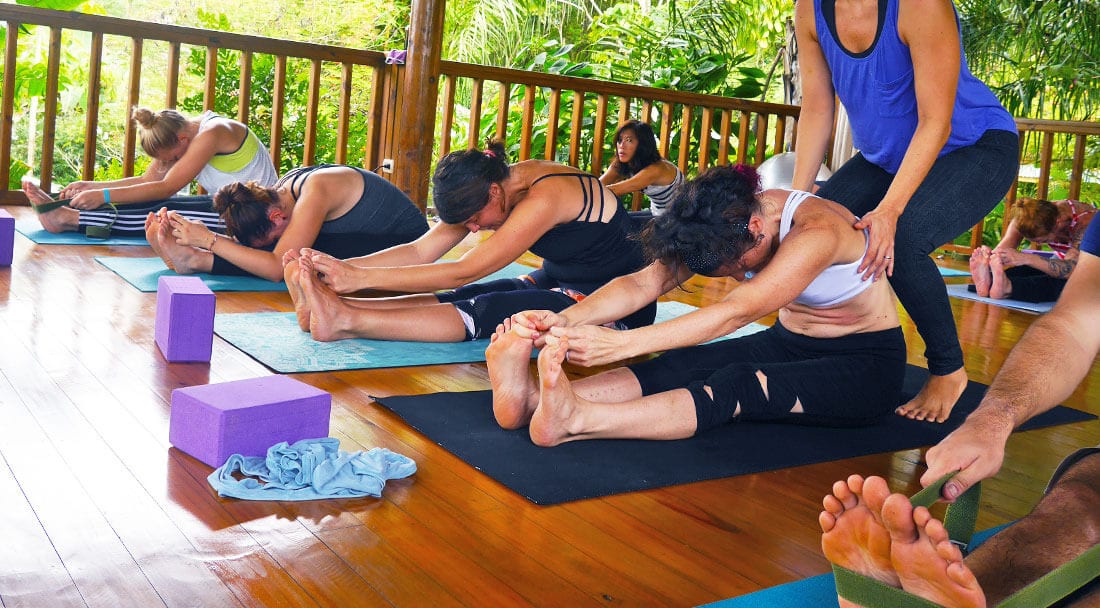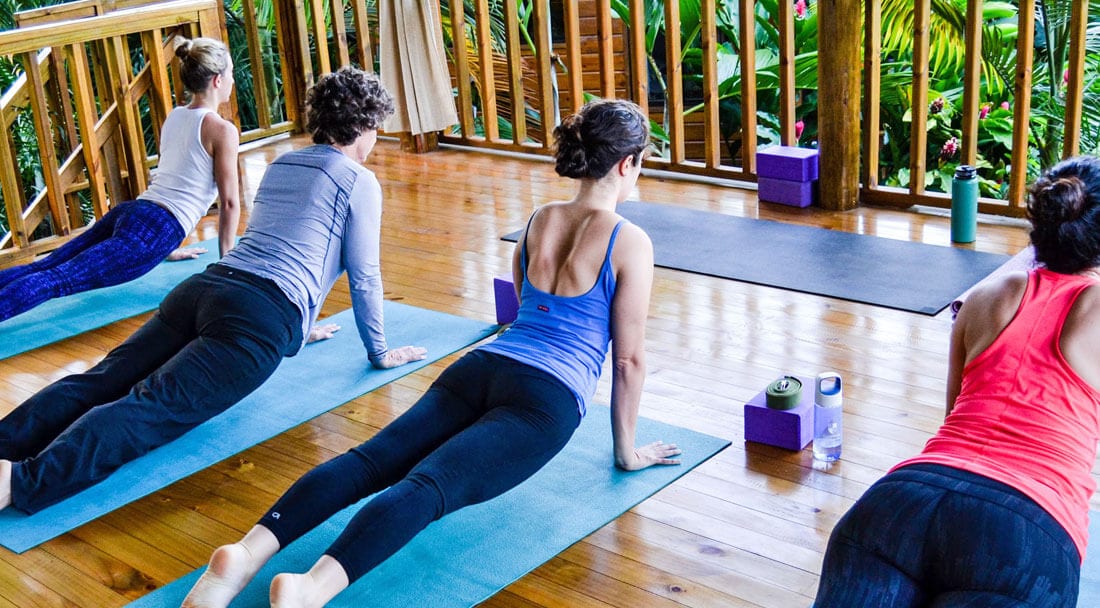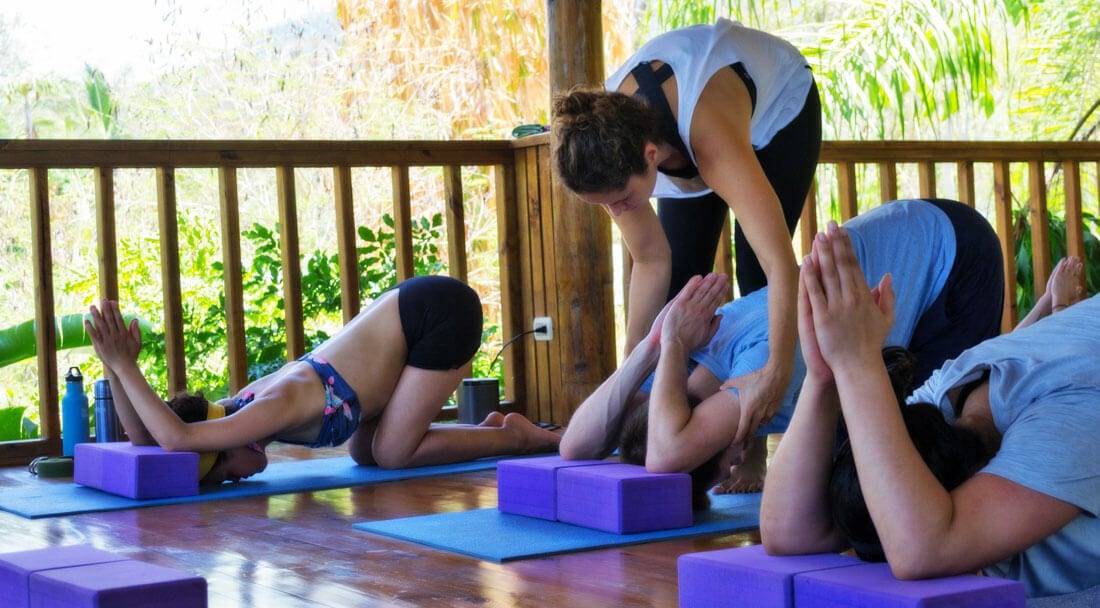Unfortunately, there is no short answer for the question “is it necessary to use props in yoga class?”. If there were, I probably wouldn’t be here writing a blog about it, and you wouldn’t be here wanting to learn more. Certain types of yoga were originally designed for 12-year-old boys boys from India; their youth, genetics, and lack of injury made them flexible so there was no need for blocks, straps, or bolsters. But we are (most likely) not 12-year-old boys. We are adults with injuries, desk jobs, and in some cases, minimal flexibility. It’s for this reason why yoga props can be an extremely valuable part of your practice. But that’s all they should be — a part of it. Keep reading to find out how to use yoga props to grow your yoga practice without holding you back.

It depends on the teacher
It all comes down to picking a good yoga teacher for you, as some teachers have more training and experience than others. They will be able to give you modifications if a pose is inaccessible to you. Sometimes these poses involve blocks and sometimes they don’t. If they offer you blocks or other yoga props, take them! This is your opportunity to get closer to a correct posture without overextending, damaging, or hurting yourself. Some teachers are not comfortable teaching you how to use props or simply prefer not to use them. In this case they might offer modifications to a pose such as reaching for your shins instead of your feet in a forward fold. Each teacher has their unique strengths. His or her individual style and experience will determine whether or not they use blocks or other props in their class.
Sometimes teachers might use yoga props, not necessarily because students can’t access the posture, but to access or examine the posture from a different perspective, or work in an specific area of the body.

Don’t get too attached
Props are great for deepening your practice. As adults with injuries, and who likely sit in a chair all day, it’s likely that you’ll find certain poses more accessible to you when you have props. When used correctly, yoga props can also help you avoid injury in your yoga practice. But it’s important not to get attached to them. They are like training wheels — designed to make a pose easier at first. If you usually a use a prop in a particular pose, try going without it next time. Yoga is an incredible practice because there’s always further you can go. You can always get more flexible, stronger, and more balanced. A block or strap can help you increase those elements but eventually removing it is very important for growth within your practice.
A prime example of this is utilizing the wall when you do an inversion. We like doing handstands against a wall because we know it will catch us if we start to go over a bit. But knowing the wall is there means you can be slightly soft. You don’t have to engage your abs as much, you don’t have to recruit your lats, you don’t even need proper alignment to do a handstand against a wall. But if you actually want to see growth and development in your practice, you need to hop off the wall from time to time. That’s when you realize exactly which muscles you need to activate in order to properly hold a handstand. You’ll feel your body respond to shifts in balance and learn exactly which muscles you need in order to balance on your hands, forearms, or head.

Props are great but…
Yoga props help our rigid western bodies find more ease and stillness in a new pose. They make poses that would otherwise be inaccessible achievable to injured, tight, or unstretched bodies. They are a great addition to a regular yoga practice. But they should not become a crutch. Use them to understand proper alignment and then stop using them. Create the desired shape in your body without props. This will deepen your yoga practice as you become more aware of your own limits and then learn how to breathe into them.
So, yoga props or no yoga props? Every teacher will have a different answer for this question. Some teachers love them, some don’t. You have to take into consideration that teachers teach based on their 200-300-500 hours of training, their own experience in the practice, and what they have seen work for past students. As a practitioner you also have the right (and the responsibility) to explore what works for you and what doesn’t. In the end, our own yoga practice is our real teacher, the instructor is there to hold the space and guide us safely through our practices. My advice is, do your own exploration, be open to all the possibilities, and see for yourself what works best for you. Keep an open mind, your practice, and what you believe works for you might change over time, so stay open and curious to the possibilities.
Written by Katie Jones
Get a Toolkit to Create Calm in Your Inbox
Watch the first lesson from our full immersive course: 8 Limbs of Ashtanga Yoga, FREE!
Change the heading on the Separator tab ->
Search
Get a Toolkit to Create Calm in Your Inbox
Watch the first lesson from our full immersive course: 8 Limbs of Ashtanga Yoga, FREE!
Change the heading on the Separator tab ->
Most Read Blogs
What is the Meaning of Anjali Mudra?
May 27, 2020
Fitness for Surfers: Workouts, Exercises & Training
February 10, 2022
The Best Places to Eat in Uvita, Costa Rica
May 19, 2022
How to Get From SJO to Costa Ballena, Costa Rica
May 31, 2018
Change the heading on the Separator tab ->
Categories
Categories
- Bodysurfing (5)
- Food (7)
- Responsible Business (6)
- Surfing (63)
- Travel (64)
- Yoga (41)
Change the heading on the Separator tab ->
Newsletter
Thanks for subscribing! Please check your email for further instructions.
Change the heading on the Separator tab ->
Follow Us
Bodhi Surf + Yoga
Change the heading on the Separator tab ->
Read more
5 Advanced PNF Stretches for Surfing
Words by Guest Post
Like in any sport, surfing requires exceptional mobility and range of motion in the joints. Stretching is a great tool to gain mobility for those eye-catching maneuvers or a post-session recovery routine….
A Typical Day: Bodhi Sessions 7 Day Surf + Yoga Camp
Words by George Frost
If you’re looking for a surfing and yoga experience that inspires, educates, and empowers – look no further! Our Bodhi Sessions 7 Day Surf + Yoga Camp is designed to help you…
A Typical Day: Bodhi Sessions 14 Day Surf + Yoga Camp
Words by George Frost
If you’re looking for a surfing and yoga experience that inspires, educates, and empowers – look no further! Our Bodhi Sessions 14 Day Surf + Yoga Camp is designed to help you…



